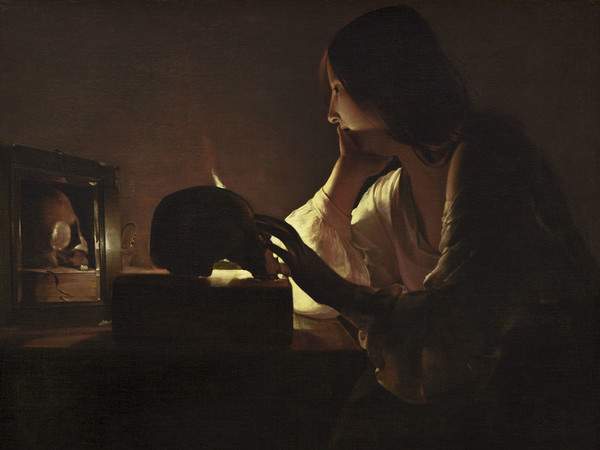In Milan, Palazzo Reale opens its doors to Georges de La Tour. Europe of Light, the first exhibition in Italy dedicated to the most celebrated French painter of the 17th century and his relationship with the great masters of his time scheduled from February 7 to June 7, 2020.
Curated by Francesca Cappelletti, the exhibition was made posible thanks to a scientific committee composed of Pierre Rosenberg (former director of the Louvre), Gail Feigenbaum (director, Getty Research Institute), Annick Lemoine (director, Musée Cognacq-Jay), and Andres Ubeda (deputy director, Prado Museum). The exhibition compares the French master’s masterpieces with those of other greats of his time(Gerrit van Honthorst, Paulus Bor, Trophime Bigot, Frans Hals and others) to bring a new reflection on genre painting and “luministic experimentation,” to address the profound questions that still shroud the work of this mysterious artist.
The exhibition at the Royal Palace and the studies in the catalog intend on Georges de la Tour’s painting, characterized by a profound contrast between the “diurnal” themes, cruelly realistic, showing an unfiltered existence, with faces marked by poverty and the inexorable passing of time, and the “nocturnal” themes with splendid figures illuminated by candlelight: absorbed, silent, moving models. A powerful contrast between the pitiless world of the “diurnal” and the compassionate depiction of the “nocturnal” scenes is still striking today. Paintings that preserve the secret of their origin and destination. Just as the painter’s training remains a mystery, including the possibility or otherwise of his Italian journey.
There are thirty works attributed with certainty to La Tour (none of which are preserved in Italy), and the Royal Palace will exhibit the best of them, such asThe Penitent Magdalene (on loan from the National Gallery of Art in Washington, D.C.), The Struggle of the Musicians(J. Paul Getty Museum) and The Hurdy Gurdy Player with Dog(Musée du Mont-de-Piété in Bergues).
The particularity of his works is the depiction of subjects taken from the street and, therefore, of low status, rather than high-ranking figures and historical figures.
“In addition to being the artist of nights, or the artist of reality, a reality that when observed closely shows all its ambiguity, ”says curator Francesca Cappelletti, “La Tour is the artist of minimal variations, of nuance, of the elusive difference between one composition and another, sometimes different only by chromatic tones, sometimes by subtle shifts in meaning. La Tour’s pictures are absolutely enthralling, prompting one to sharpen one’s eyesight to discover what lurks in the darkness, where candlelight fails to reach; or they are paintings that show us more than we would like to see (the despair and misery of life, which gigantes near us). Looking at his paintings, the viewer is involved on a par with the painter in the same enterprise; he cannot look away from the work, until he is captured by its author: this is one of the secrets of his ascendancy.”
Georges de la Tour (Vic-sur-Seille,1593 - Lunéville, 1652), is one of the great artistic rediscoveries of the twentieth century. Since 1915, when the German Hermann Voss published a revealing article on his work, the seventeenth-century French painter has not ceased to fascinate entire generations of art historians, who have been doing their utmost to search for documents, paintings and preparatory drawings thattestify the activity of an extraordinary, unconventional and exciting artist. La Tour was a highly esteemed painter in his day, original for his mixture of spirituality and realism, always poised between delicacy and brutality. Often looked upon with a certain diffidence: father of 11 children, difficult in character and with a large number of stray dogs. Yet he was successful first in the Duchy of Lorraine where he was born, and then in Paris where he was appointed, in 1639, painter to King Louis XIII. He is an enigmatic artist, portraying angels taken from the people, saints without haloes or iconographic attributes, and preferring subjects taken from the street, such as beggars, painting generally low-ranking people rather than historical models or high-ranking figures. The few paintings recognized as autograph are mostly small or medium format, intimate, without landscape backgrounds, nocturnal, and, especially in his alleged last artistic phase, almost monochromes with a geometric layout, simple but very modern for the time. His traces, and those of his work, were lost, however, throughout the 18th and 19th centuries, not only that, but also because of the wars for independence that ravaged his homeland.
The project involves a high number of lenders (28 from three continents), with some of the largest international institutions such as the National Gallery of Art in Washington, Washington, the Getty Museum in Los Angeles, the Frick Collection in New York, the San Francisco Fine Art Museum, the Chrysler Museum in Norfolk, the National Art Gallery in Lviv, and many French regional museum institutions, such as the Musée des Beaux-Arts in Nantes, the Musée du Mont du Piété in Bergues, the Musée départemental d’Art ancien et contemporain in Epinal, the Museée des Beaux-Arts in Dijon, the Musée Toulouse-Lautrec in Albi, the Musée départemental Georges de La Tour in Vic-sur-Seille, and some important Italian museums such as the Uffizi Gallery, the Pinacoteca Vaticana, and the National Gallery of Ancient Art in Palazzo Barberini.
For all information you can visit the official website of the Royal Palace.
Pictured: Georges de La Tour, Penitent Magdalene, detail (1635-1640; oil on canvas, 113 x 92.7 cm; Washington, National Gallery of Art)
 |
| Milan holds first exhibition in Italy on Georges de la Tour with masterpieces from international museums |
Warning: the translation into English of the original Italian article was created using automatic tools. We undertake to review all articles, but we do not guarantee the total absence of inaccuracies in the translation due to the program. You can find the original by clicking on the ITA button. If you find any mistake,please contact us.